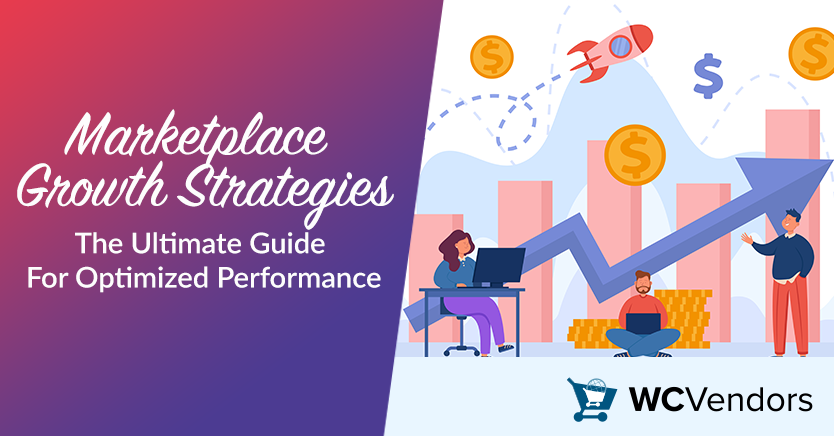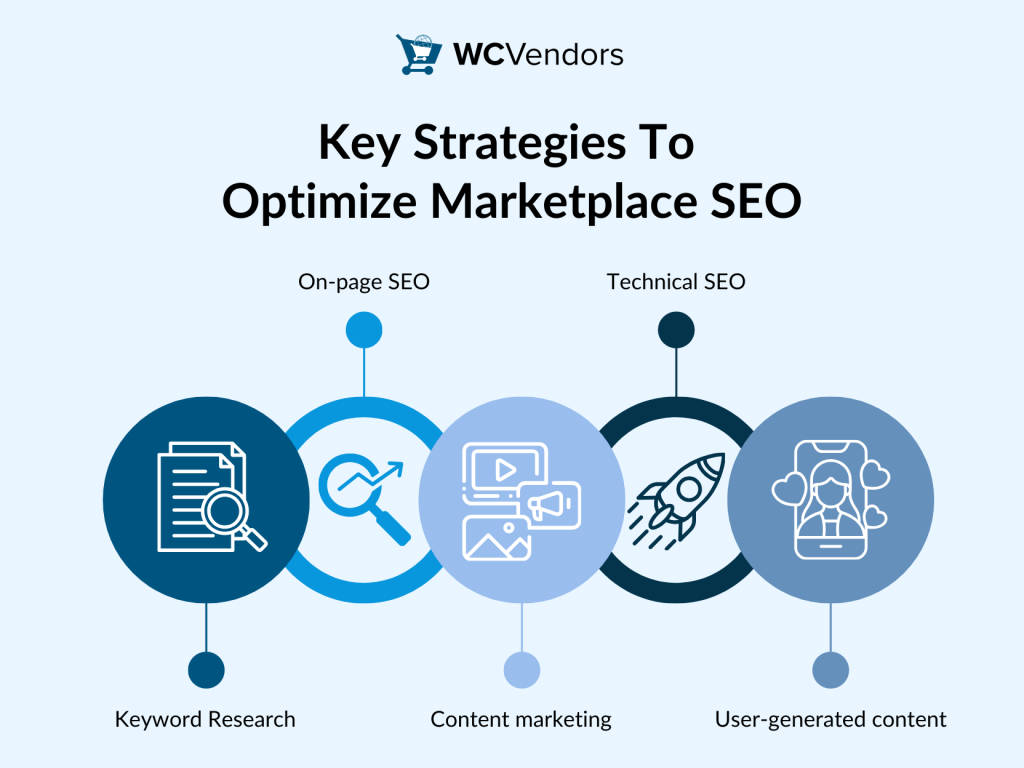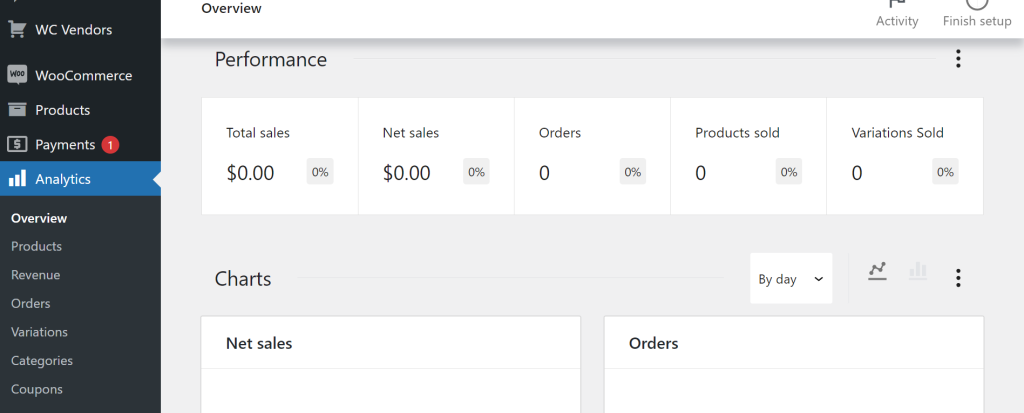
Did you know that marketplace giants like Amazon operate with over 9 million sellers worldwide? Effective marketplace growth strategies are crucial for any multi-vendor platform’s success.
For owners of multi-vendor marketplaces, using platforms like WC Vendors can make a big difference. This guide will show you how to set growth objectives and optimize SEO. We’ll also cover ways to encourage vendor participation and boost user engagement. Additionally, we’ll discuss leveraging social media and using data analytics. Finally, we’ll highlight the importance of prioritizing customer service. With WC Vendors, these strategies become easier to implement, driving the success of your marketplace.
Let’s get started!
Setting Growth Objectives And KPIs
One of the key marketplace growth strategies is setting clear growth objectives and key performance indicators (KPIs). For any successful business, knowing what you aim to achieve is, indeed, crucial. Therefore, start by defining what success looks like for your multi-vendor marketplace. For instance, do you want to increase the number of active vendors, boost user acquisition, or enhance transaction volumes?
Once you have defined your objectives, establish specific, measurable KPIs to track your progress. Relevant examples include:
- Monthly Active Users (MAUs)
- Vendor Onboarding Rate
- Gross Merchandise Volume (GMV)
- Customer Retention Rate
- Cart Abandonment Rate
If your goal is to increase sales, consider KPIs like monthly sales growth, average order value, and conversion rates. With tools like WC Vendors, you can also efficiently track these metrics. Consequently, this helps you stay on course and make informed decisions to drive your marketplace forward.
Once you have these metrics in place, the next logical step is to ensure potential customers can actually find your marketplace by optimizing your SEO.
Optimizing Marketplace SEO
Implementing effective marketplace growth strategies can significantly enhance your multi-vendor platform’s visibility and success. Search engine optimization (SEO) is a powerful tool for driving organic traffic to your multi-vendor marketplace.

Here are some key strategies to enhance your SEO efforts:
- Keyword research: Start by conducting thorough keyword research. Identify the terms your target audience is searching for. Also use these keywords in product descriptions, titles, and meta tags.
- On-page SEO: Optimize product listings, vendor pages, and category pages with targeted keywords. This ensures your marketplace is easy to find and navigate.
- Content marketing: Regularly publish high-quality, relevant content such as blogs, guides, and videos. Implementing a blog on your WC Vendors site can also be an effective way to provide valuable content that attracts and engages visitors.
- Technical SEO: Ensure your website has fast loading times, mobile optimization, and clean URLs. Both these factors are critical for SEO and user experience.
- User-generated content: Leverage reviews, ratings, and user submissions to enhance your SEO efforts. User-generated content can significantly boost your site’s credibility and relevance.
By combining these strategies, you can significantly improve your marketplace’s visibility. As a result, this will help you draw more organic traffic. Ultimately, it will lead to sustained growth and success.
To keep this momentum, getting your vendors to join in on marketing can really boost your marketplace’s reach and variety.
Read on further to find out how to get your vendors involved!
Encouraging Vendor Marketing Participation
One of the unique advantages of a multi-vendor marketplace is the chance for collective marketing efforts. By encouraging your vendors to promote their products and your marketplace, you can significantly boost visibility and sales. Therefore, here are some key strategies to consider:
Incentivize vendors
- Offer promotions, discounts, or credits for vendors who effectively market their products.
- Consider creating a vendor marketing program with rewards for those who bring in new customers or achieve high sales volumes.
Provide marketing tools
- Supply vendors with marketing resources such as banners, templates, and social media guidelines.
- Offer SEO tips to help vendors improve their product listings and website presence.
Vendor training programs

- Educate vendors on best practices for online marketing, sales optimization, and also customer communication.
- Offer workshops or webinars to provide hands-on training and support.
By fostering a collaborative marketing environment, you can effectively expand your reach and attract more buyers. Additionally, working closely with vendors ensures a collective effort in driving traffic and sales. This collaboration is one of the key marketplace growth strategies that leads to the overall success and growth of your multi-vendor marketplace.
Once your vendors are on board, the next step is to keep users engaged and coming back. Let’s explore how to enhance user engagement and retention!
Enhancing User Engagement And Retention
User engagement and retention are crucial for a thriving marketplace. High engagement often leads to repeat customers and increased loyalty. To achieve this, focus on the following key strategies:
Personalized recommendations
- Use data to suggest products based on user behavior.
- Make each visit more relevant and engaging by tailoring recommendations to individual preferences.
Community building
- Create forums, discussion groups, or social media communities.
- Allow users to connect, share experiences, and interact with each other.
Loyalty programs
- Implement a loyalty program that offers rewards like points or discounts for repeat purchases and referrals.
- Encourage users to return and make more purchases by providing tangible incentives.
User-friendly interface

- Ensure both your web and mobile platforms provide a smooth and intuitive experience.
- Include features like easy navigation, detailed product descriptions, high-quality images, and customer reviews.
Consistent engagement:
- Engage your users consistently to maintain their interest and loyalty.
- Use personalized email campaigns and push notifications to keep users informed about new products, promotions, and exclusive offers.
By focusing on these marketplace growth strategies, you can create a seamless and enjoyable shopping experience that encourages users to return. Consequently, this will drive the growth and success of your multi-vendor marketplace.
Now, let’s see how social media and influencer partnerships can take your marketplace to the next level. Read on further!
Using Social Media And Influencer Partnerships
Social media is a powerful tool for promoting your marketplace and engaging with your audience. Therefore, as part of your marketplace growth strategies, begin by identifying the platforms where your target audience is most active. Next, create a consistent posting schedule. Additionally, share a mix of content to keep your followers interested. This can include product highlights, user-generated content, and behind-the-scenes insights.
Influencer partnerships can also boost your marketplace growth. Thus, partner with influencers who align with your brand. Ensure they have a substantial following in your niche. They can help you reach a broader audience. In addition, influencers can build credibility through authentic endorsements.
Together, these strategies can effectively enhance user engagement and retention.

- Instagram product highlights
- Use Instagram Stories and Posts to showcase top-selling products with high-quality images and videos.
- Example: A fashion marketplace can feature a “Product of the Week” series, highlighting different vendors’ items with styling tips and purchase links.
- User-generated content (UGC) campaigns
- Encourage customers to share photos of their purchases with a specific hashtag. Repost these images on your social media.
- Example: A home decor marketplace can run a contest where customers post pictures of their decorated spaces using products for a chance to win a gift card.
- Behind-the-scenes insights
- Share behind-the-scenes content to humanize your brand and connect with your audience.
- Example: A handmade goods marketplace can post stories showing artisans crafting their products, highlighting the care and effort involved.
- Influencer unboxing videos
- Partner with influencers to create unboxing videos of your products, generating excitement and providing a detailed look.
- Example: A tech gadget marketplace can send new gadgets to tech influencers for unboxing and review, offering followers an authentic first look.
- Live Q&A sessions with influencers
- Host live Q&A sessions on social media platforms.
- Influencers discuss and answer questions about your products.
- Example: A beauty and skincare marketplace can collaborate with beauty influencers to discuss skincare routines, answer questions, and recommend products.
- Sponsored giveaways
- Run sponsored giveaways with influencers to boost engagement and attract new followers.
- Example: A book marketplace can team up with a popular bookstagrammer to give away a curated box of books, requiring followers to like, share, and tag friends to enter.
Marketplace owners can use social media and influencer partnerships to grow and engage their audience. These marketplace growth strategies help improve performance.
Next, let’s explore how data can help you make smart decisions. Read on further to learn about leveraging analytics for data-driven decisions!
Leveraging Analytics For Data-Driven Decisions
Data analytics is essential for making informed decisions and also optimizing your marketplace performance. To begin, use analytics tools to track user behavior, sales trends, and marketing campaign effectiveness. Consequently, this data will provide valuable insights into what’s working and what needs improvement.
For example, if you see that a certain product category is doing very well, you can expand that category or promote it more. On the other hand, if a marketing campaign is underperforming, you should analyze the data to find out why. Then, adjust your strategy accordingly. WC Vendors offers built-in analytics to help you monitor these critical aspects of your business.
Data is a goldmine when it comes to marketplace growth strategies. Leveraging analytics can help make informed decisions:
- Track user behavior: Use tools like Google Analytics to monitor how users interact with your marketplace.
- A/B testing: Experiment with different versions of your site to see which performs better.
- Sales analytics: Monitor sales trends to identify successful products and vendors.
- Customer feedback: Collect and analyze feedback to understand user needs and pain points.
Using analytics can help you understand user behavior and identify trends. As a result, you can make data-driven decisions to improve your marketplace and drive growth.
Let’s see how excellent customer service can also play a vital role in your marketplace’s growth. Read on further!
Examining The Role Of Customer Service In Growth
Excellent customer service is a cornerstone of successful marketplace growth strategies. Ensure that both your vendors and customers receive prompt and helpful support. Implement a robust customer service system that includes multiple channels such as live chat, email, and phone support.
Training your customer service team to handle various issues well is crucial. Happy customers are also more likely to return and recommend your marketplace. Therefore, encourage vendors to prioritize customer service too. Their interactions with buyers directly affect your marketplace’s reputation.

Quality customer service helps your marketplace stand out in a crowded market. Furthermore, it builds trust and loyalty, which are essential for long-term success.
Here are steps to ensure superior customer service:
- Multi-channel support: Offer support through various channels such as email, chat, phone, and social media.
- Response time: Ensure fast and efficient responses to customer inquiries.
- Follow-up: After resolving a query, follow up to ensure customer satisfaction.
- Feedback loops: Regularly seek feedback to improve your services.
Excellent customer service creates positive experiences, thereby driving user retention and word-of-mouth referrals. Moreover, this holistic approach ensures your marketplace thrives in a competitive environment.
Conclusion
Adopting strong marketplace growth strategies is essential for multi-vendor marketplaces. By implementing this approach, you can boost performance and ensure long-term success.
For instance, imagine facing a dip in customer engagement or noticing that sales have plateaued. These are common issues many marketplaces encounter. However, by addressing these challenges head-on, you can turn them into opportunities for growth.
Here is a recap of the sections in the article:
- Setting clear KPIs
- Optimizing SEO
- Engaging vendors
- Enhancing user engagement
- Leveraging social media
- Utilizing data analytics
- Providing exceptional customer service
Evaluating and continuously adapting these strategies will set your marketplace on the path to long-term success. After all, isn’t that what every business aims for? If you have any questions, please feel free to contact us.
Remember, the journey to success is ongoing. Therefore, stay proactive and keep refining your strategies!

